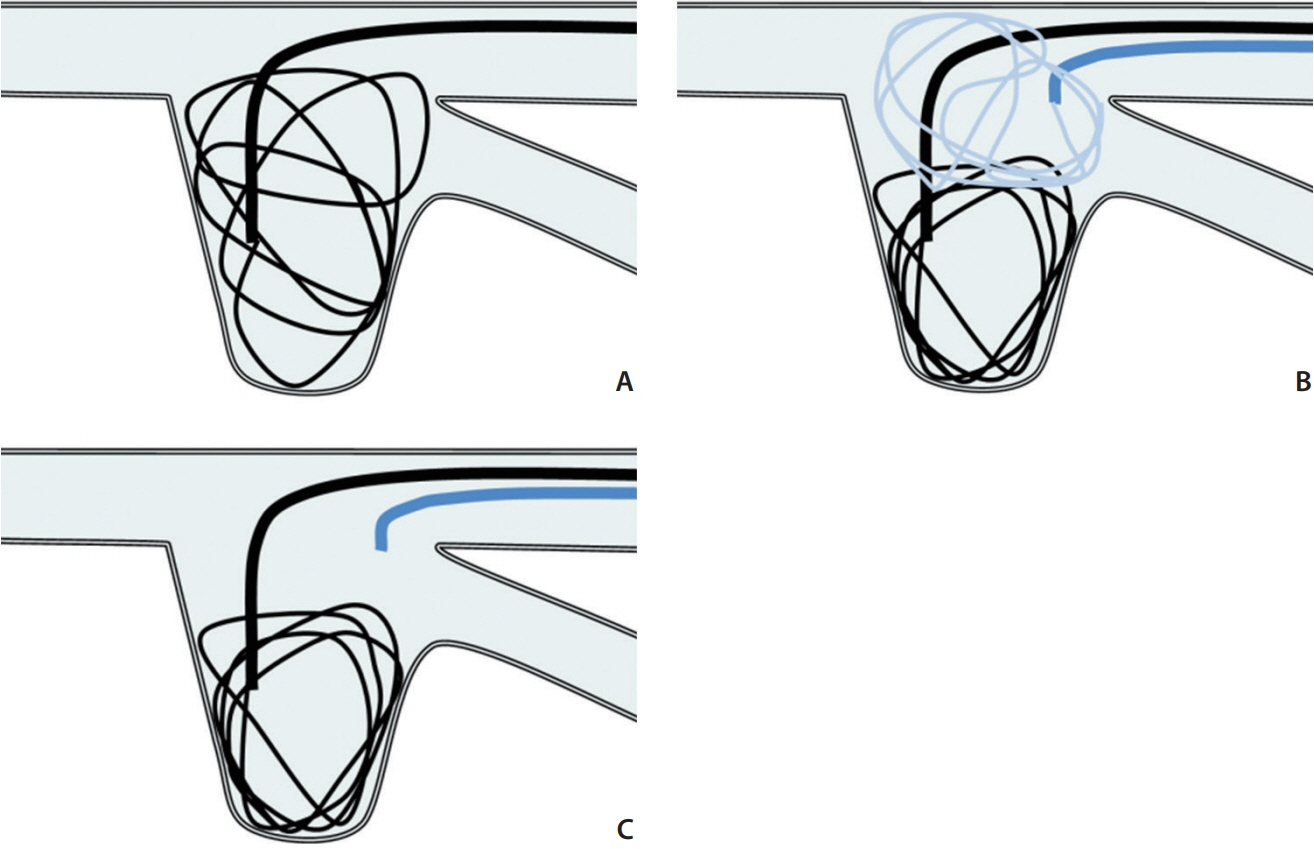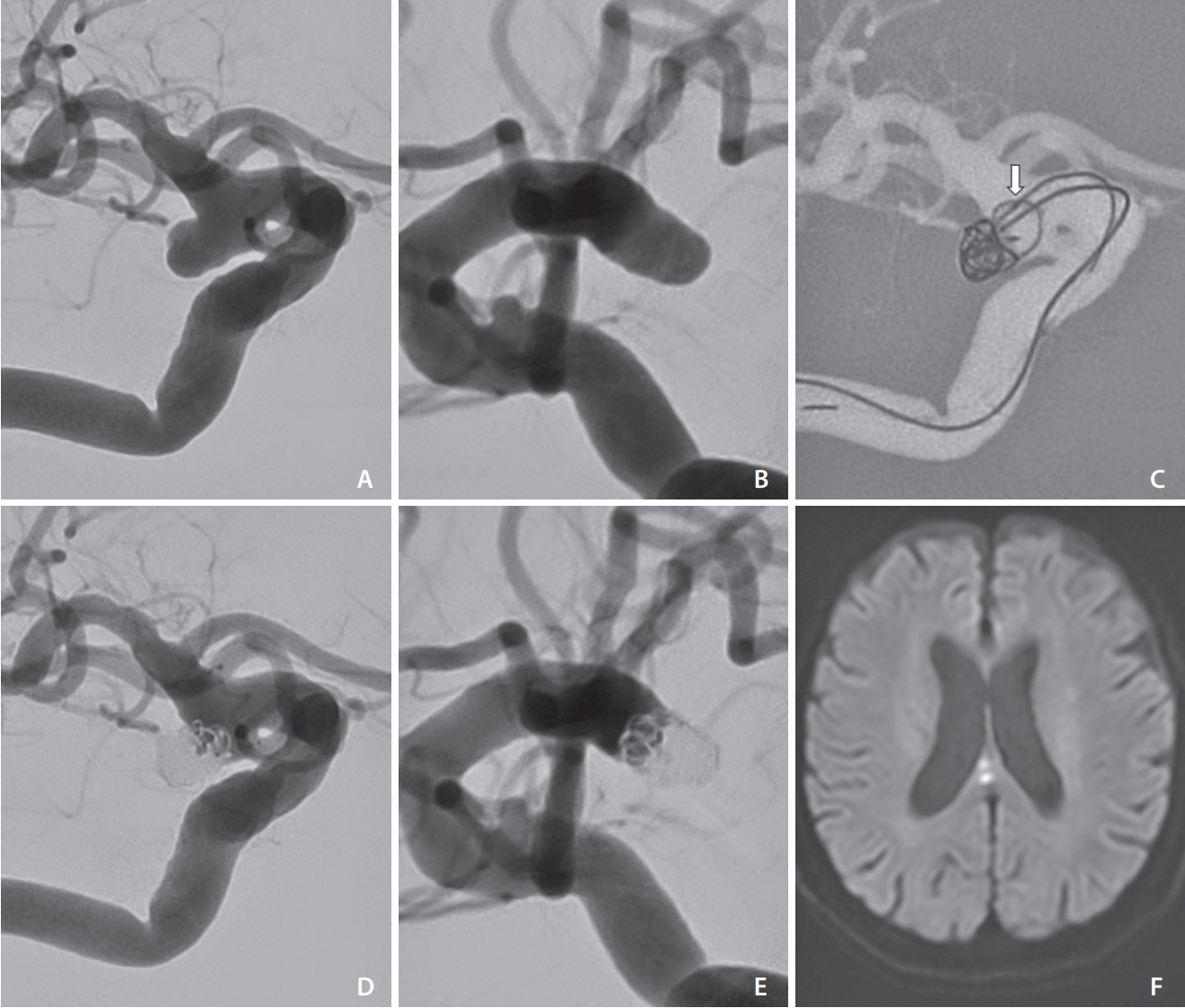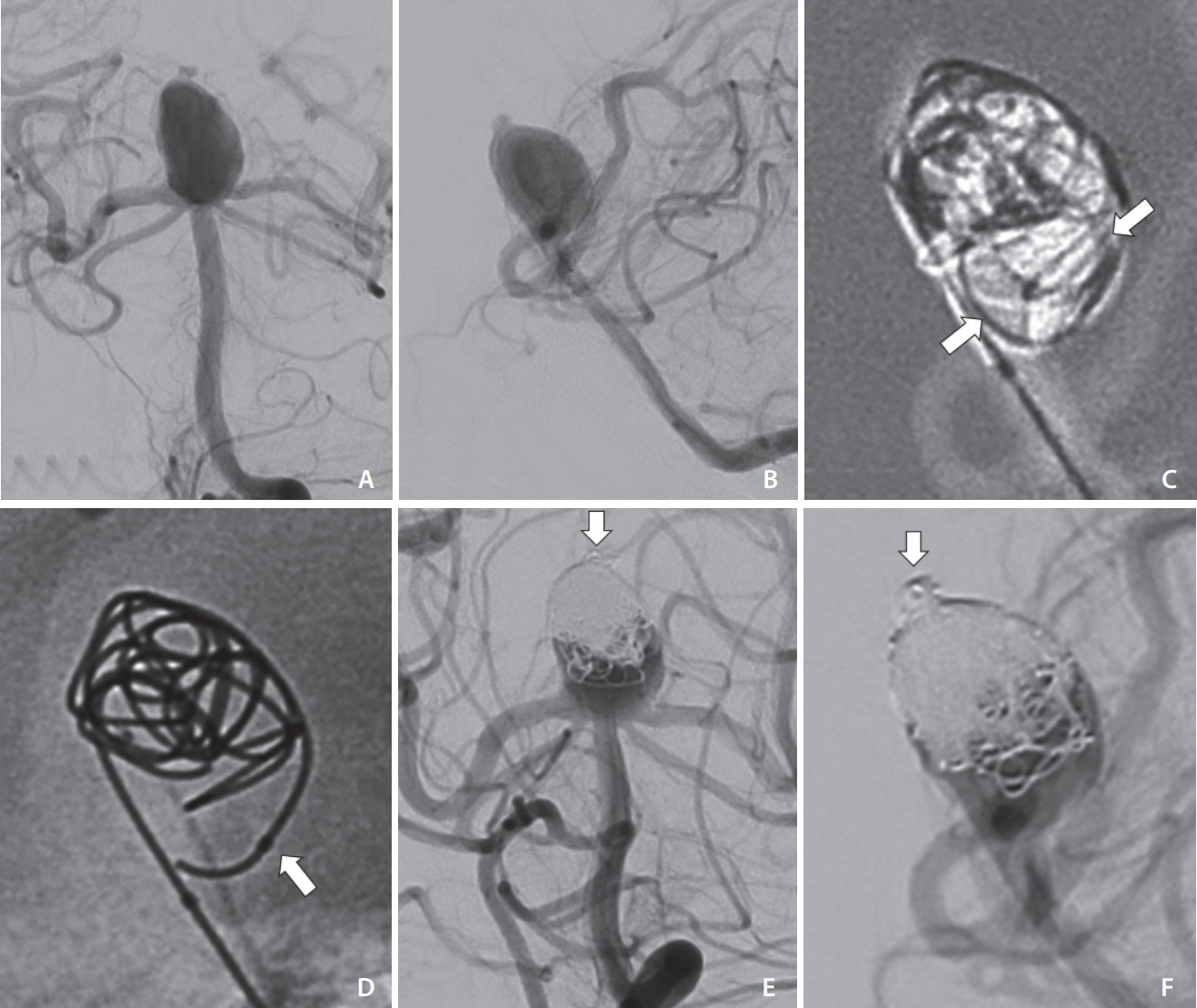Neurointervention.
2022 Jul;17(2):115-120. 10.5469/neuroint.2022.00136.
Parent Artery Complex Coil Protection for Side-Branched Wide-Neck Aneurysms
- Affiliations
-
- 1Department of Neurosurgery, Toyama Prefectural Central Hospital, Toyama, Japan
- KMID: 2531568
- DOI: http://doi.org/10.5469/neuroint.2022.00136
Abstract
- This study aimed to validate the usefulness of parent artery complex coil protection for the treatment of wide-neck, side-branched, and ruptured aneurysms. A microcatheter was first introduced into the aneurysmal sac, and another microcatheter was introduced into the parent artery or near the orifice of the branch artery. A framing coil was deployed partially from the first microcatheter, and a protection coil was deployed from the second microcatheter to prevent protrusion of the first framing coil to the parent artery and side branches. After the first framing coil insertion, the protection coil was withdrawn to confirm the stability of the framing coil and blood flow. The procedures with this technique were successful for 3 patients. Parent artery complex coil protection can be an effective and safe coil embolization technique for the preservation of parent and side branch arteries and an alternative method for emergent ruptured cases.
Keyword
Figure
Reference
-
1. Gordhan A. Microcatheter neck bridging and incorporated branch vessel protection for coil embolization of a wideneck ruptured aneurysm: technical case report. Neurosurgery. 2011; 68(1 Suppl Operative):40–43. discussion 43-44.
Article2. Peluso JP, van Rooij WJ, Sluzewski M, Beute GN. A new self-expandable nitinol stent for the treatment of wide-neck aneurysms: initial clinical experience. AJNR Am J Neuroradiol. 2008; 29:1405–1408.
Article3. Weber W, Bendszus M, Kis B, Boulanger T, Solymosi L, Kühne D. A new self-expanding nitinol stent (Enterprise) for the treatment of wide-necked intracranial aneurysms: initial clinical and angiographic results in 31 aneurysms. Neuroradiology. 2007; 49:555–561.
Article4. Pierot L, Cognard C, Spelle L, Moret J. Safety and efficacy of balloon remodeling technique during endovascular treatment of intracranial aneurysms: critical review of the literature. AJNR Am J Neuroradiol. 2012; 33:12–15.
Article5. Lee JY, Seo JH, Cho YD, Kang HS, Han MH. Endovascular treatment of wide-neck intracranial aneurysms using a microcatheter protective technique: results and outcomes in 75 aneurysms. AJNR Am J Neuroradiol. 2011; 32:917–922.
Article6. Cho YD, Lee JY, Seo JH, Lee SJ, Kang HS, Kim JE, et al. Coil protection using small helical coils for wide-neck intracranial aneurysms: a novel approach. AJNR Am J Neuroradiol. 2013; 34:164–168.
Article7. Cho YD, Rhim JK, Park JJ, Jeon JP, Kang HS, Kim JE, et al. Modified coil protection for proper coil frame configuration in widenecked aneurysms. Neuroradiology. 2015; 57:705–711.
Article8. Ihn YK, Kim BM, Suh SH, Kim DJ, Kim DI. Coil-protected embolization technique for a branch-incorporated aneurysm. Korean J Radiol. 2013; 14:329–336.
Article9. Cho YD, Lee WJ, Kim KM, Kang HS, Kim JE, Han MH. Endovascular coil embolization of middle cerebral artery aneurysms of the proximal (M1) segment. Neuroradiology. 2013; 55:1097–1102.
Article10. Cho YD, Kang HS, Kim JE, Son YJ, Lee JY, Lee SJ, et al. Microcatheter looping technique for coil embolization of complex configuration middle cerebral artery aneurysms. Neurosurgery. 2012; 71:1185–91. discussion 1191.
Article11. Kwon OK, Kim SH, Kwon BJ, Kang HS, Kim JH, Oh CW, et al. Endovascular treatment of wide-necked aneurysms by using two microcatheters: techniques and outcomes in 25 patients. AJNR Am J Neuroradiol. 2005; 26:894–900.12. Yang MS, Yang TH, Ou CH, Chan SW, Chen TI, Yang CJ, et al. Complex coil assisted single coil embolization for small intracranial aneurysm. Neurointervention. 2013; 8:105–109.
Article
- Full Text Links
- Actions
-
Cited
- CITED
-
- Close
- Share
- Similar articles
-
- Microcatheter-assisted Coil Embolization of Distal Vertebral Artery Wide-Necked Aneurysm: A Case Report
- Complex Coil Assisted Single Coil Embolization for Small Intracranial Aneurysm
- Endovascular Management of the Wide-neck Aneurysms: the Applications of the Coils and Catheter
- Usefulness of "Double-catheter" Technique in GDC Treatment of Intracranial Wide-necked Aneurysm
- Multimodal Treatment for Complex Intracranial Aneurysms: Clinical Research




